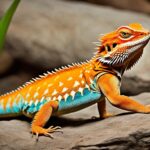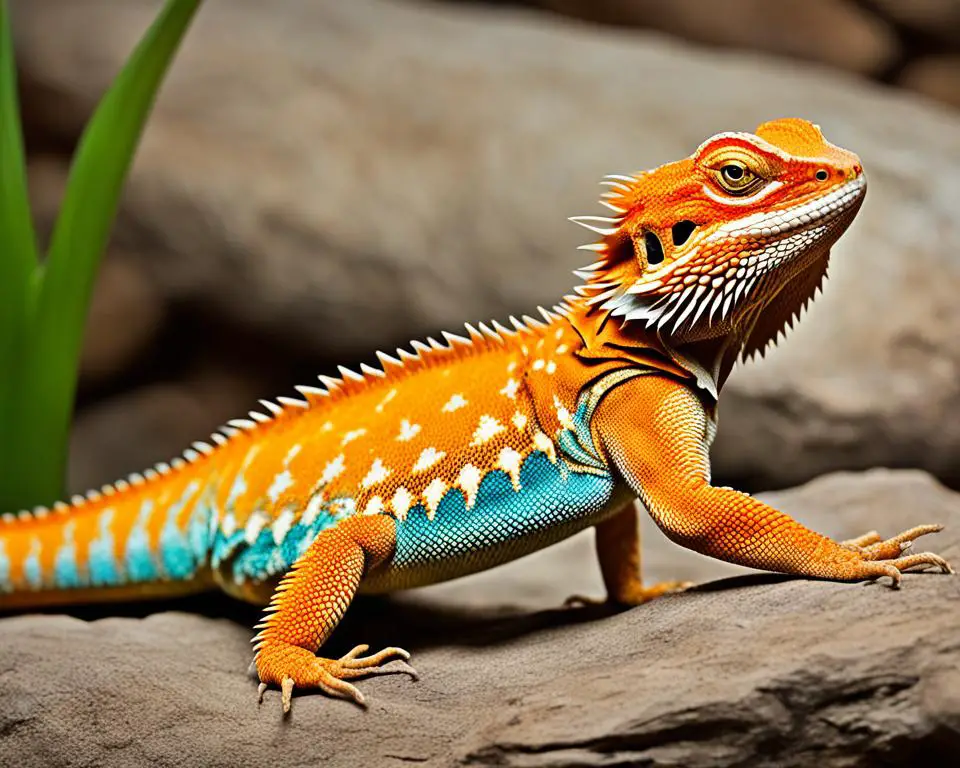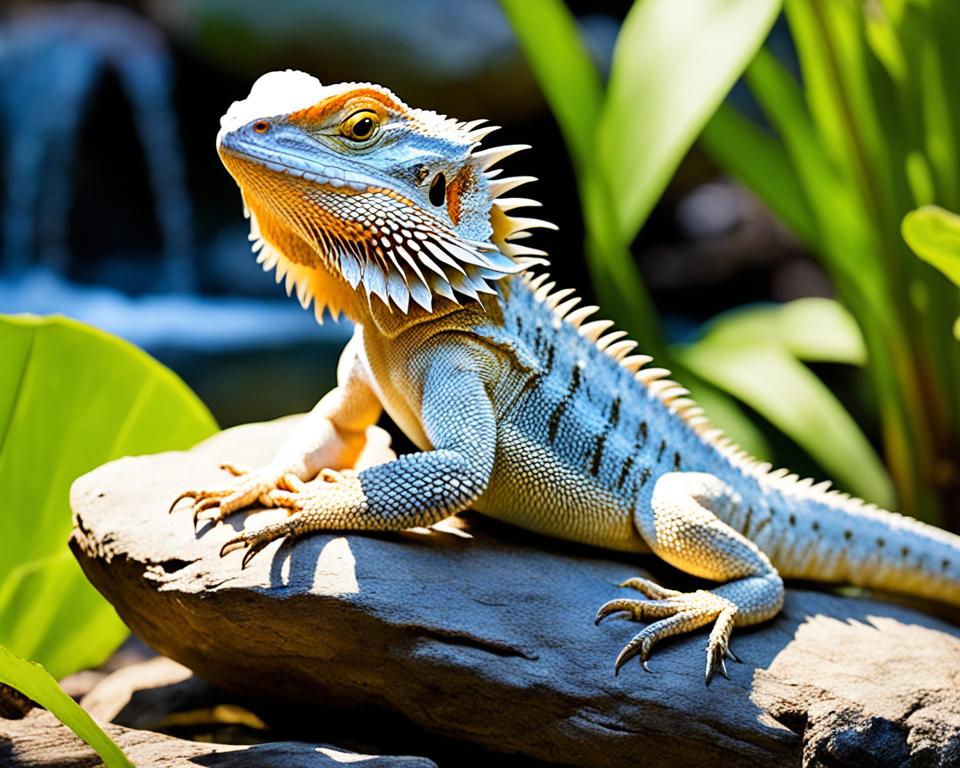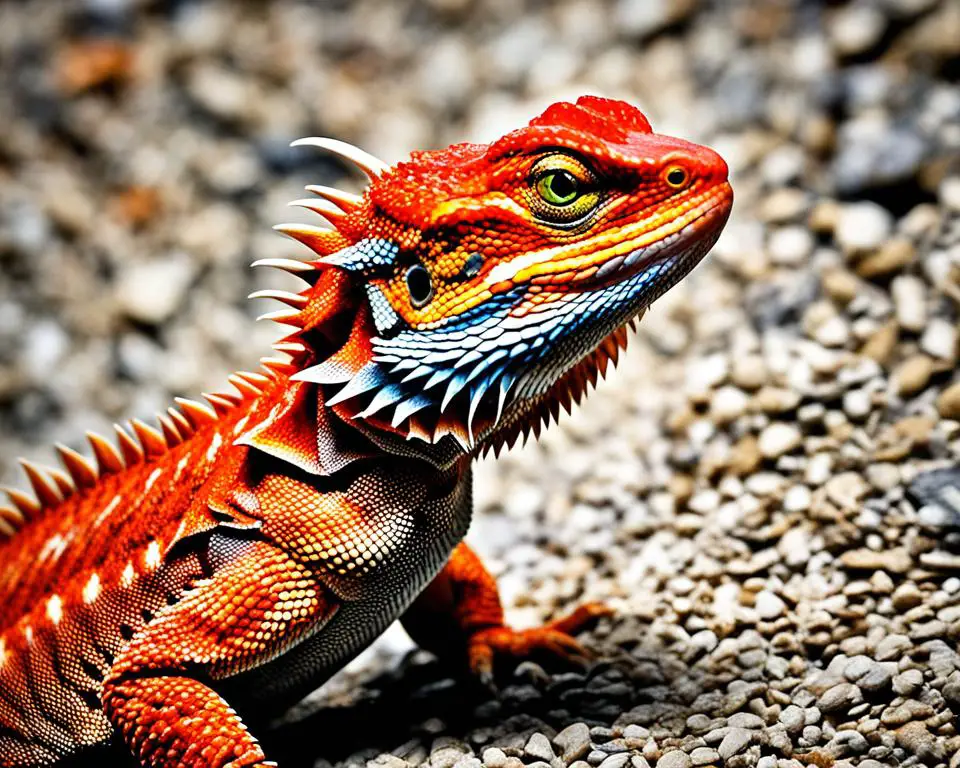The German Giant morph bearded dragon is known for its large size and special traits. It’s a favorite among reptile lovers. These dragons can get as big as 25-30 inches, much bigger than usual. They became popular pets in the 1990s in the US, and the German Giant morph is especially sought after.
Looking after these amazing creatures means knowing what they need. They need lots of room to live and a diet that meets their needs. Because they are rare, they can be more expensive. This makes them a cherished pet for collectors and fans.
Introduction to German Giant Bearded Dragons
German Giant Bearded Dragons are a special type of bearded dragon, known for their big size and unique traits. They are popular among reptile fans for their size and easy-going nature. These dragons add a special touch to any collection.
What are German Giant Bearded Dragons?
These dragons are like standard bearded dragons but much bigger. They grow from 16-24 inches long. Breeders focused on their genetics to make them larger and stronger. This has made them a favorite among lizard lovers.
History and Origin
The German Giant comes from Australia. It entered the US reptile market in the 1990s. Breeders picked certain traits to make a bigger species. This led to a breed with strong genetics, known for its size and adaptability.
Natural Habitat
German Giants live in Central and Eastern Australia’s semi-arid and subtropical woodlands. They need temperatures of 82-87°F and humidity of 30-45%. They’re used to moderate rainfall, which affects their care in captivity.
Creating a natural habitat helps these dragons stay healthy and behave naturally. Knowing their background is key to caring for them well.
Physical Characteristics
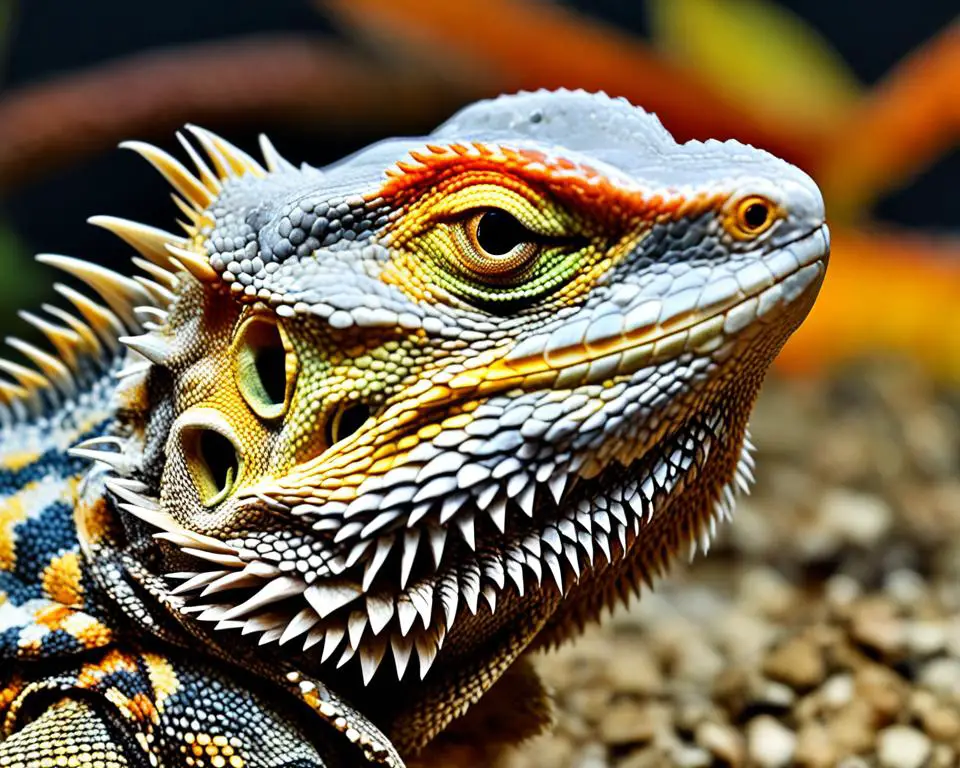
German Giant bearded dragons are known for their German Giant traits. These traits set them apart from other bearded dragons. They are bigger and have special features that make them interesting to bearded dragon fans.
Size and Appearance
German Giant bearded dragons can grow up to 30 inches long. This is longer than the usual 24 inches for other types. Their size is a key German Giant trait. They look like regular bearded dragons but are bigger in every way.
They are also heavier and more solid. This comes from careful breeding. Their scales, colors, and textures are like those of regular bearded dragons but stand out more because of their size. These traits make German Giants a top choice for those who want a big and impressive pet.
Lifespan
German Giants don’t live as long as some other bearded dragons. While regular bearded dragons can live 10-20 years, German Giants usually live 4 to 8 years. This is because they are bigger and have certain health issues.
Even with a shorter life, German Giants offer special experiences. Their size means they can move and interact more with their owners. With the right care, like a good home, food, and vet visits, they can live a happy life.
German Giant Bearded Dragon Enclosure Setup
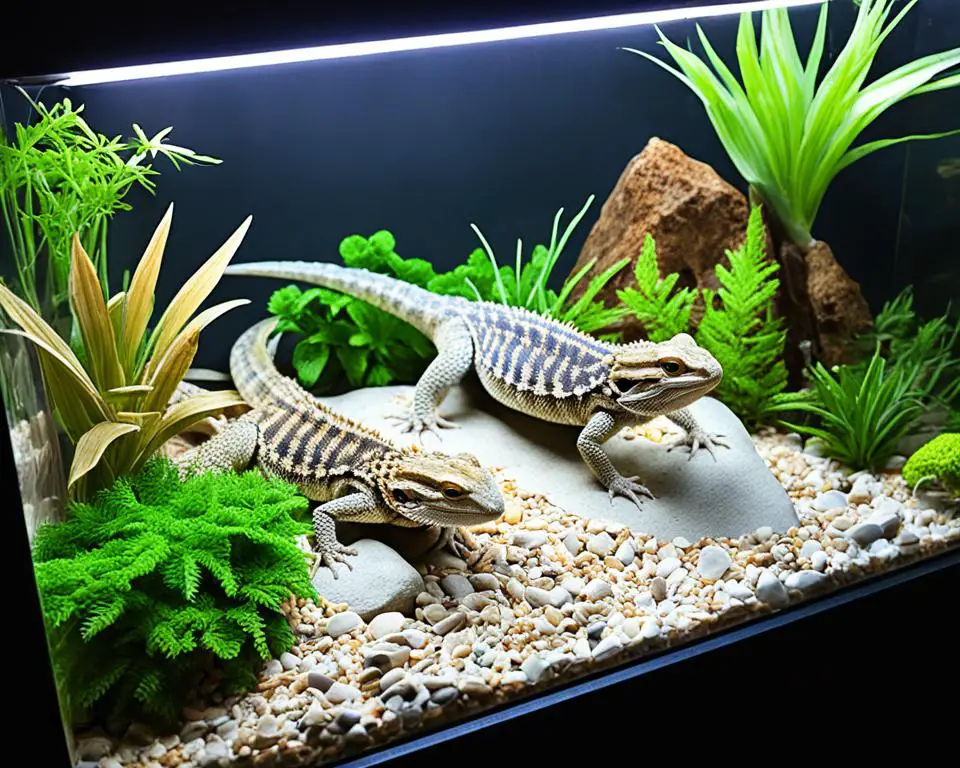
Setting up a great home for German Giant Bearded Dragons needs careful thought. They need lots of space and the right kind of ground to live well.
Tank Size and Dimensions
Adult German Giants can get up to 30 inches long. So, they need a big tank. The smallest tank should be 100 gallons. A bigger vivarium, like 120 x 60 x 60 cm, is best to give them room to move.
The tank should have a cool and a hot side. The hot side should be between 100–107°F. This helps with digestion and keeps them healthy.
Recommended Substrate
Choosing the right ground for your bearded dragon is key. You can use sand, newspaper, ceramic tiles, or reptile carpet. Sand and newspaper are cheaper, but reptile carpet and ceramic tiles help prevent health problems.
Companies like Custom Reptile Habitats have big tanks for big reptiles. Add strong branches and fake plants for them to climb on. This makes their home feel more natural and keeps them happy and healthy.
Heating and Lighting Requirements
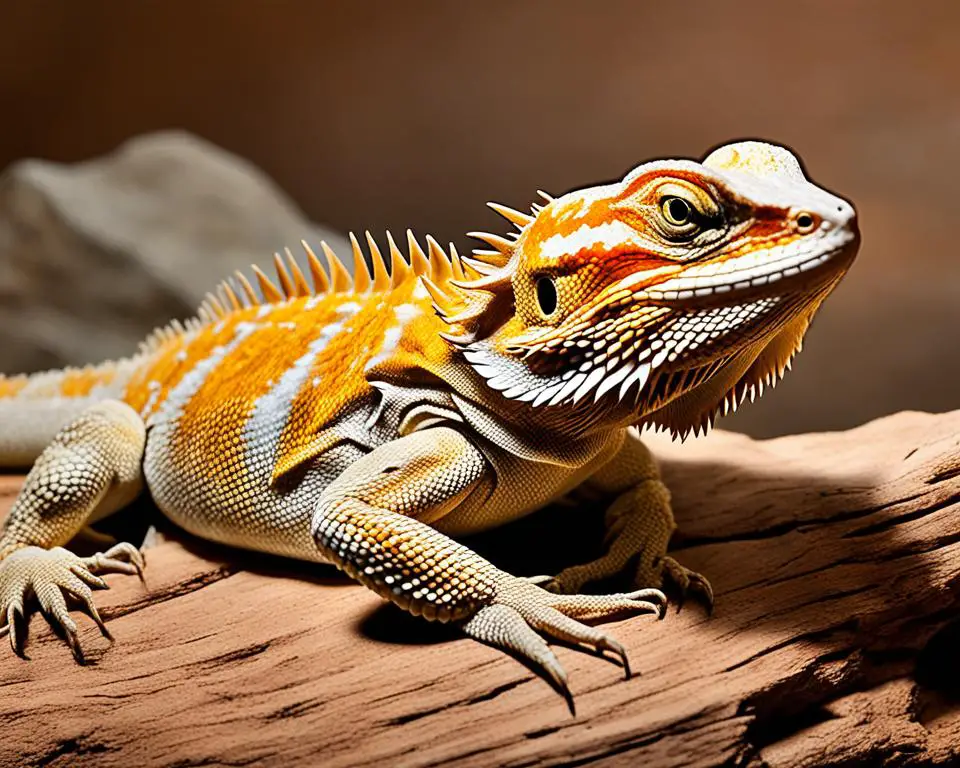
For your German Giant Bearded Dragon’s health, the right heating and lighting are key. This guide will cover the best ways to heat your terrarium, use UVB lighting, and control humidity.
Heating Options
For these dragons, heating needs a mix of sources. Popular choices include under-tank heating pads, basking lights, and ceramic heat emitters. Always use thermostats to keep the temperature steady.
- Basking lights: Good options are high-wattage halogen bulbs like the 200w Infrared Gold Unit or Arcadia Halogen Heat Lamp.
- Ambient heating: For even heat, try lightless options like the Sweeter Heater Radiant Heat Panel, Arcadia Deep Heat Projector, and Zoo Med ReptiCare Infrared Heat Projector.
- Thermal gradient: Set up a temperature gradient with hot spots (108-113°F) for basking and cooler areas (70-85°F) for the rest of the enclosure.
Lighting Options
Good lighting is crucial for bearded dragons. It helps with their metabolism and vitamin D3 production. Use linear fluorescent UVB lighting, keeping the basking area 9-11 inches away with mesh, or 14-18 inches without.
- UVB lighting for reptiles: Choose T8 or T5 fluorescent bulbs and replace them every 6-12 months for best results.
- UVA/UVB combination: Mixing UVA and UVB rays mimics natural sunlight, which is important for their health.
- Daylight cycle: Follow a 14-hour light cycle in summer and 10 hours in winter to match their natural day-night pattern.
Temperature and Humidity
Getting the right temperature and humidity is key for bearded dragons. Aim for a hot spot of 120-130°F and a cooler area of 70-75°F, with the rest at 85°F. At night, let the temperature drop to 60-70°F without extra heat.
| Temperature Zone | Recommended Temperature |
|---|---|
| Basking Surface | 105-115°F (40-46°C) |
| Cool Zone | 70-85°F (21-29°C) |
| Nighttime | 60-70°F (16-21°C) |
Keep humidity at 35-40% to mimic their dry natural habitat. High humidity can be harmful, so check and adjust it often. Use hygrometers to monitor humidity levels.
By focusing on UVB lighting, heating systems, and humidity control, you can make sure your German Giant Bearded Dragon stays healthy and happy.
Diet and Feeding
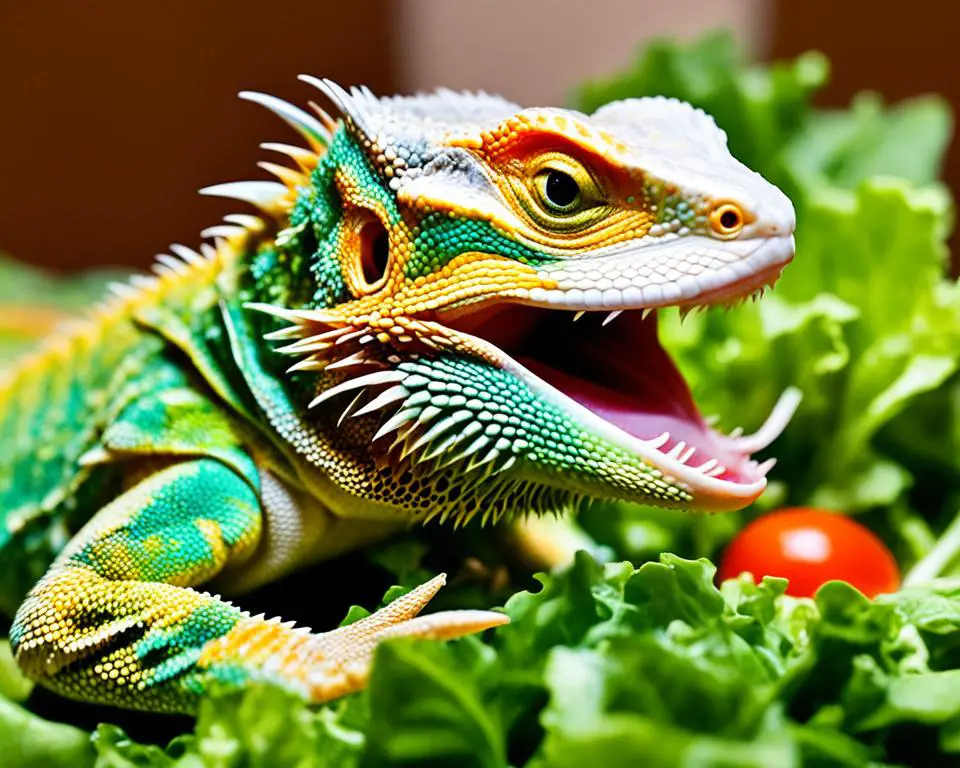
It’s key to know what German Giant bearded dragons need to eat to stay healthy. They eat both plants and insects, so a balanced diet is important. This mix helps them grow and stay healthy.
Dietary Needs
Bearded dragons need both animal and plant food. Young ones eat a lot of protein to grow fast. They like crickets, mealworms, and dubia roaches.
As they get older, they eat more plants. Aim for 75% plants in their diet. This helps them stay healthy and avoids health problems.
Appropriate Foods
Feeding bearded dragons right keeps them happy and healthy. Here’s what they should eat:
- Insects: Crickets, mealworms, and dubia roaches
- Vegetables: Arugula, bell peppers, collard greens, and squash
- Fruits:A small portion of fruits like blueberries and strawberries
- Supplements: Calcium and vitamin D3 powders to support bone health
Feeding Schedule
Feeding them at the same time every day is important. Here’s a schedule for different ages:
| Age | Diet Composition | Feeding Frequency |
|---|---|---|
| 0-6 months | 75% insects, 25% plants | 2-3 times a day |
| 6-12 months | 50% insects, 50% plants | 1-2 times a day |
| 12+ months | 25% insects, 75% plants | Once a day |
Follow these tips and adjust for your dragon’s needs. This ensures they get a balanced diet. It helps them stay healthy and live a long life.
Health and Wellness
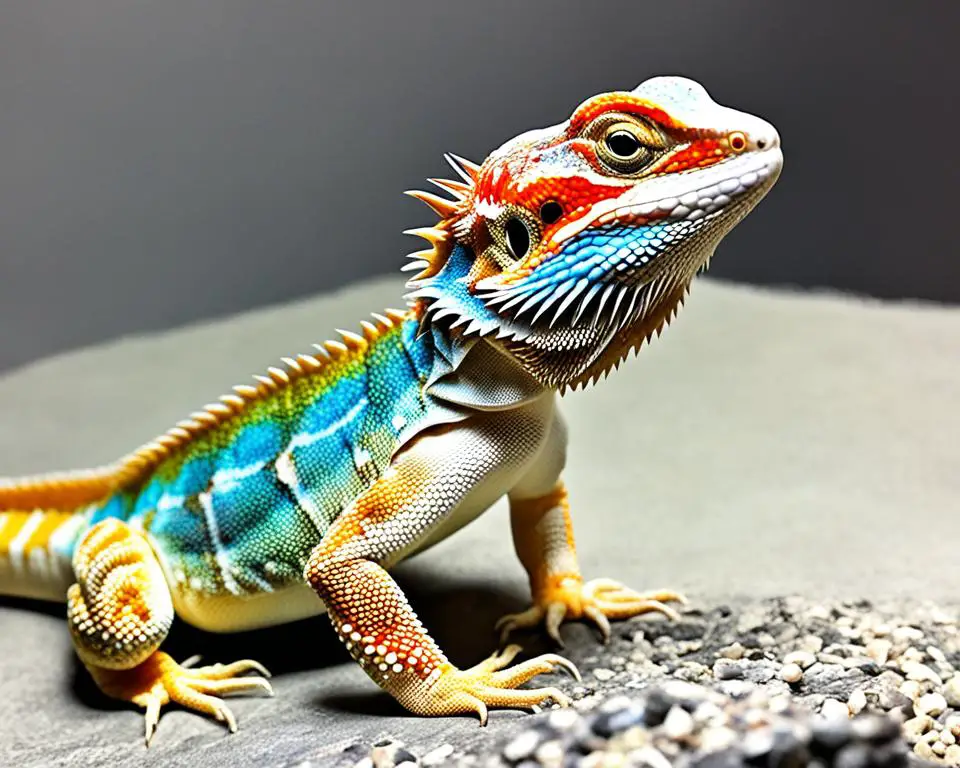
Keeping your German Giant Bearded Dragon healthy is key to a long, happy life. With the right care, you can avoid many common problems. This keeps your bearded dragon happy and healthy.
Common Health Issues
German Giant Bearded Dragons face health issues like metabolic bone disease, impaction, and respiratory infections. Metabolic bone disease happens when they don’t get enough UVB light or eat a diet low in calcium. Impaction is when they eat something they shouldn’t, like substrate, and it blocks their digestive tract. Respiratory infections can come from bad humidity or poor living conditions.
Preventative Care
Preventing health problems is crucial for your bearded dragon. A balanced diet of insects and veggies, with extra calcium, helps avoid metabolic bone disease. Clean their home often and make sure they get enough UVB light. Also, keep an eye on the temperature and humidity in their tank to prevent respiratory problems. These steps are key to keeping your reptile healthy.
Finding a Reptile Veterinarian
It’s important to have a vet who knows about veterinary care for reptiles. Regular vet visits and getting advice early can help spot health problems early. Reptile vets can give your pet the best care and suggest treatments if needed.
| Health Issue | Prevention Tips |
|---|---|
| Metabolic Bone Disease | Ensure adequate UVB light and provide calcium supplements |
| Impaction | Avoid loose substrates and monitor food intake |
| Respiratory Infections | Maintain proper humidity and clean the enclosure regularly |
By being careful and proactive, you can help your bearded dragon stay healthy and happy.
Behavior and Temperament
German Giant Bearded Dragons are known for being friendly and calm. They make great pets for both new and seasoned reptile lovers. These reptiles are active during the day and rest at night. Watching their behavior can tell you a lot about their health.
Typical Behaviors
Knowing how bearded dragons behave helps you meet their needs. German Giants often bob their heads, wave their arms, and bask in the sun. These actions are ways they talk to humans or other dragons. They eat both insects and vegetables, like crickets and bell peppers.
By spending time with them, you can learn their habits and create a better home for them.
Handling Your German Giant
Handling German Giant Bearded Dragons right is key. It’s best to hold them for 15 minutes, twice a day, to keep them calm. Always hold them securely and move slowly to avoid scaring them.
Regular, gentle handling helps you bond with your pet. It also keeps them friendly and well-adjusted. Remember, each dragon is different, and some might not like being handled as much.
Breeding and Lifespan
Reptile breeding with German Giant Bearded Dragons requires special care. Their size and health come from specific genes. Breeders need lots of space and must watch out for health problems.
Breeding Considerations
These dragons lay more eggs than Inland Bearded Dragons because they are healthier. To breed them well, you must feed them right and keep their homes clean. They eat greens, fruits, veggies, and insects.
Cleaning their cages with a bleach solution is also key. This keeps them healthy and ready to breed.
Expectations for Pet Lifespan
German Giant Bearded Dragons can live five to eight years, sometimes up to 12 with great care. Their diet, living space, and vet visits are very important. Washing them once a week helps with shedding and staying hydrated.
Following these tips keeps your bearded dragon happy and healthy for a long time.
Where to Buy a Bearded Dragon German Giant
Looking to buy a bearded dragon, especially a German Giant? It’s important to know where to start and what to look for. This ensures you get a healthy, well-bred dragon.
Reputable Breeders
For a quality German Giant Bearded Dragon, work with reputable breeders. Carolina Designer Dragons Breeders offer a variety of female breeders with unique lineages. They have dragons from lines like Phantom Dragons and FairyTail Dragons.
Female breeders like Glo Bug, Lava, Penny, and male breeders like Jack, Red Bull, and Sizzle have distinct traits. Their breeding programs focus on quality, ensuring you get a top-notch dragon.
Online Marketplaces
Online marketplaces like MorphMarket are also good for buying bearded dragons. Here, you can find a wide range of exotic pets. Reviews and ratings help you check the seller’s quality and reliability.
But, always make sure to ask about the dragon’s lineage and breeding practices. Forums like this thread offer valuable advice and breeder recommendations.
Reptile Conventions and Expos
Reptile conventions and expos, like Repticon, are great places to find German Giant Bearded Dragons. These events bring together many breeders and vendors. You can see the dragons up close and ask breeders about their genetics and care.
Attending these events is a great way to learn and make a smart choice when buying a bearded dragon.
Whether you’re looking at reputable breeders, online marketplaces, or reptile conventions, focus on the dragon’s health and lineage. Knowing about the breeders’ practices helps you get a well-bred German Giant. This ensures a happy life for both the pet and its owner.
“Participants in reptile forums often emphasize that the actual size differences between German Giants and regular bearded dragons can vary, but breeding practices and the dragons’ lineage play the most significant role in determining the overall size and health of these incredible pets.”
Cost of Ownership
Owning a German Giant Bearded Dragon comes with many expenses. These include costs for both the start and ongoing care. This ensures the reptile stays healthy and happy.
Initial Costs
The cost to get a German Giant Bearded Dragon is quite high. Prices range from $300 to $500, depending on the lizard’s age, where it comes from, and its type. Here’s what you’ll need to spend upfront for your new pet:
- Bearded Dragon: Buying one can cost between $300 and $500.
- Enclosure: You’ll need a 75-gallon tank, which costs a lot.
- Heating and UV Lighting: These can cost from $15 to $150, depending on what you choose.
- Equipment: You’ll also need hygrometers, thermometers, thermostats, and UPS devices for the right care.
- Accessories: Things like decor, feeding tongs, insect housing, and substrate will add to the cost.
Ongoing Maintenance Costs
After buying and setting up your pet, you’ll need to keep up with ongoing costs. These are for keeping your bearded dragon healthy. Here are some monthly and yearly costs:
- Food: Feeding your bearded dragon can cost from $50 to $125 a month, based on your situation and where you live.
- Electricity: Keeping the right temperature and lighting in the tank costs money.
- UVB Bulb Replacements: You’ll need to replace these bulbs every six months for your pet’s health, costing $12 to $40.
- Veterinary Care: You’ll need to visit the vet once a year, and sometimes for emergencies, with costs for supplements too.
German Giant owners should be ready for changing costs each month. Planning for both the start and ongoing care is key. This way, owning a German Giant can be fulfilling without financial surprises.
Conclusion
Caring for a German Giant Bearded Dragon is rewarding but requires attention to detail and resources. These creatures can live 5-8 years, making them shorter-lived than smaller types. Their size and friendly nature make them popular among reptile lovers.
Understanding the costs is key. The initial cost is about $350, and yearly care can hit up to $200. A 100-gallon tank is a must for their growth, with humidity levels between 20% to 40%. The right food, substrate, and accessories are also crucial for their health.
They eat insects like crickets, grasshoppers, and mealworms. Fruits and veggies like arugula and cucumbers are also good for them. For more details on their care, check out the German giant bearded dragon care guide.
Handling them is a joy but should be limited to 15 minutes twice a day. Avoid handling during shedding. With the right care, you and your German Giant Bearded Dragon will have a rewarding experience.
Source Links
- A Beginner’s Guide to Bearded Dragon Colors & Morphs
- Dependable Bearded Dragon Care Information – Reptile.Guide
- The Complete Care Guide For Mini Bearded Dragons – Berry Patch Farms
- Bearded Dragon
- A practitioner’s guide to bearded dragons
- Pogona
- Bearded Dragon Morphs
- 11 Types Of Bearded Dragon Morphs
- Bearded Dragon – Pogona vitticeps (Keeper’s Choice)
- German Giant Bearded Dragon: Size, Pictures, Habitat & Care Guide | Hepper
- How Big Should My Beardies House Be?
- What Morphs Do Bearded Dragons Come In?
- Bearded Dragon Lighting, Heating & Humidity Requirements
- Bearded Dragon Complete Lighting and Heating Guide
- Bearded Dragon heat and light
- How to know if you have a giant German?
- Feeding and Caring for Bearded Dragons
- Central bearded dragon
- Bearded Dragons – Learning More About Bearded Dragons
- German Giant Bearded Dragon: Facts, Care & Info (with Pictures) | PangoVet
- German Giant Bearded Dragon Care Sheet: Crucial Info & Pics!
- German giant bearded dragon…tips?
- Lifespan of German Giant Bearded Dragons
- Bearded Dragon Care Guide (Detailed Care Sheet)
- How to look after a Bearded Dragon
- Breeders – Carolina Designer Dragons
- German Giants?
- How Much Do Bearded Dragons Cost? Budgeting the Real Costs
- How Much Does A Bearded Dragon Cost? Species Price Guide
- Types of Bearded Dragons » View Different Types, Colors, & Species

